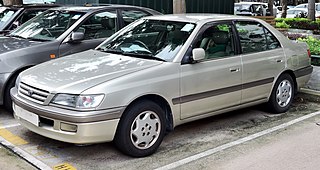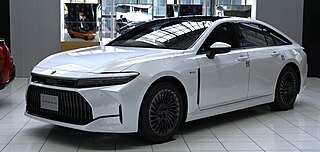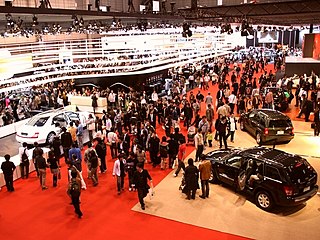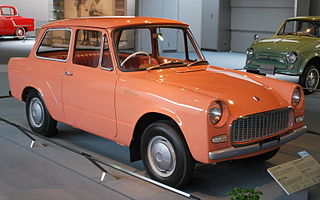
The Toyota Corona is an automobile manufactured by the Japanese automaker Toyota across eleven generations between 1957 and 2001. On launch, the Corona was Toyota's second-highest product in their range, just below the Crown. The Corona was marketed in the JDM at Toyota's Toyopet Store dealership channels, and the Corona was one of Toyota's first models exported to other global markets, followed by the smaller Toyota Corolla.

The Prince Motor Company was an automobile marque from Japan which eventually merged into Nissan in 1966. It began as the Tachikawa Aircraft Company, a manufacturer of various airplanes for the Japanese Army in World War II, e.g., the Ki-36, Ki-55 and Ki-74. Tachikawa Aircraft Company was dissolved after the war and the company took the name Fuji Precision Industries. It diversified into automobiles, producing an electric car, the Tama, in 1946, named for the region the company originated in, Tama, using the Ohta series PC/PD platform. The company changed its name to Prince in 1952 to honor Akihito's formal investiture as Crown Prince of the nation. In 1954 they changed their name back to Fuji Precision Industries, and in 1961 changed the name back again to Prince Motor Company. In 1966, they became part of Nissan, while the Prince organization remained in existence inside Nissan, as Nissan Prince Store in Japan until Nissan consolidated the Prince dealership network into "Nissan Blue Stage" in 1999.

The Daihatsu Compagno is an automobile which was produced by Daihatsu in Japan from 1963 to 1970. The name comes from the Italian word for "partner." The Compagno was designed to be offered in multiple bodystyles, and was introduced prior to the acquisition of Daihatsu by Toyota in 1967. The Compagno was available as a two-door sedan, four-door sedan, two-door pickup truck, a three-door delivery van and a convertible. The first Compagno prototype was shown at the 1961 Tokyo Motor Show and was of an appearance reminiscent of the Fiat 1800/2100. This was not a very well balanced design and Vignale's production version ended up looking quite different. The Compagno used a ladder-type chassis instead of the more modern monocoque style, with torsion bar wishbone suspension at the front and semi-elliptical leaf springs for the rear axle. The Compagno is also the first Daihatsu car to use the famous "D" logo.

The Toyota Century is a lineup of full-size luxury cars and limousines produced mainly for the Japanese market, serving as Toyota's flagship car within Japan; globally the unrelated Lexus LS series is Toyota's flagship luxury model. Production of the Century began in 1967, and the model received only minor changes until redesigns in 1997 and 2018.

The Toyota Mark II is a compact, later mid-size sedan manufactured and marketed in Japan by Toyota between 1968 and 2004. Prior to 1972, the model was marketed as the Toyota Corona Mark II. In most export markets, Toyota marketed the vehicle as the Toyota Cressida between 1976 and 1992 across four generations. Toyota replaced the rear-wheel-drive Cressida in North America with the front-wheel-drive Avalon. Every Mark II and Cressida was manufactured at the Motomachi plant at Toyota, Aichi, Japan from September 1968 to October 1993, and later at Toyota Motor Kyushu's Miyata plant from December 1992 to October 2000, with some models also assembled in Jakarta, Indonesia and Parañaque, Philippines as the Cressida.

The Toyota Carina is an automobile which was manufactured by Toyota from December 1970 to December 2001. It was introduced as a sedan counterpart of the Celica, with which it originally shared a platform. Later, it was realigned to the Corona platform, but retained its performance image, with distinctive bodywork and interior — aimed at the youth market and remaining exclusive to Japanese Toyota dealerships Toyota Store. It was replaced in Japan by the Toyota Allion in 2001 and succeeded in Europe by the Toyota Avensis.

The Toyota Crown is an automobile which has been produced by Toyota in Japan since 1955. It is primarily a line of mid-size luxury cars that is marketed as an upmarket offering in the Toyota lineup.

The Subaru 1000 is a car produced by the Japanese company Fuji Heavy Industries from 1966 to 1969, and until 1972 as the FF-1. It was the first front-engine, front-wheel drive Subaru, and also the first Subaru in the Japanese government "compact car" classification. Previous Subaru models such as the Subaru 360 and the Sambar had been rear-engined, rear-wheel drive kei cars.

The Japan Mobility Show (ジャパンモビリティショー), called Tokyo Motor Show (東京モーターショー) (TMS) until 2019, is a biennial auto show held in October–November at the Tokyo Big Sight, Tokyo, Japan for cars, motorcycles and commercial vehicles. Hosted by the Japan Automobile Manufacturers Association (JAMA), it is a recognized international show by the Organisation Internationale des Constructeurs d'Automobiles, and normally sees more concept cars than actual production car introductions, which is the reason why the automotive press sees the show as one of the motorshow's big five.

The Lexus LF line is a series of concept cars built by Lexus, the luxury vehicle division of Toyota Motor Corporation. The "LF" designation refers to Lexus Future. The LF Series vehicles features coupes/convertibles, including: the LF-A, the LF-A Roadster, LF-LC, LF-CC, and the LF-C; sedans: the LF-S, LF-Sh, and LF-Gh; crossover SUVs: the LF-X and LF-Xh; and hatchbacks: the LF-Ch. The first concept vehicle of the LF Series, the LF-X, appeared in 2003. The LF Series utilizes L-finesse, a design philosophy named for "Leading Edge" and "finesse", which debuted on the LF Series concepts and later extended to all new production Lexus vehicles. New vehicle technologies on the LF Series include advanced instrumentation, multiple driver-selected vehicle configurations, hybrid and experimental powertrains, and unconventional driver interface designs. The vehicles also feature new design cues which derive from the L-finesse design language of "Intriguing Elegance" (純), "Incisive Simplicity" (妙), and "Seamless Anticipation" (予). Several of the LF concept vehicles have appeared close to their production counterparts, while the design cues of other LF concepts appeared on more distinctly different production vehicles.

The Toyota Publica is a small car manufactured by the Japanese company Toyota from 1961 until 1978. Conceived as a family car to fulfill the requirements of the Japanese Government's "national car concept", it was the smallest Toyota car during that period and was superseded in that role by the Toyota Starlet, which itself started out as a version of the Publica. It was available as a 2-door vehicle only, but in a selection of body styles, ranging from the base sedan through a station wagon, convertible, coupé and even a coupe utility (pickup), which outlived the other models by a decade, and spawned other models, such as the Toyota Sports 800 and the Toyota MiniAce.
The SA was Toyota's first new passenger car design after World War II. It was the first in a family of vehicles before the introduction of the Crown. A series of light trucks also shared the chassis and major components of these passenger cars.

The Nissan Prince Royal is a large Japanese limousine made for the Imperial Household of Japan.
Toyota Concept Vehicles produced between 1980 and 1989 include:
Toyota Concept Vehicles produced between 1990 and 1999 include:
Toyota concept vehicles are transportation devices manufactured or designed by automobile company Toyota from 2000 to 2009. As their name suggests, these vehicles were concepts, and, as such, many were never released to dealerships. Many were developed in conjunction with other corporations such as Sony or Subaru.
Toyota Concept Vehicles produced between 2010 and 2019 include:

The Toyopet Master, introduced in January 1955, is a passenger car that was an evolution of the earlier Toyota SF/RH sedan with a modernized body. As with its predecessor, the Master has a ladder frame truck chassis with leaf sprung solid axles both at the front and the rear. The more conservative Master was sold in parallel with the first Toyota Crown as a frugally equipped and robust version meant for taxi usage. The Master and Crown shared the same R-series engine, which produces 48 PS (35 kW) in the Master. It was sold at a chain of Toyota Japan dealerships called Toyota Store, next to the more upscale Crown, which was intended as a private purchase alternative to the Master.
This is a list of concept vehicles made by Toyota from the years 2020–2029.














